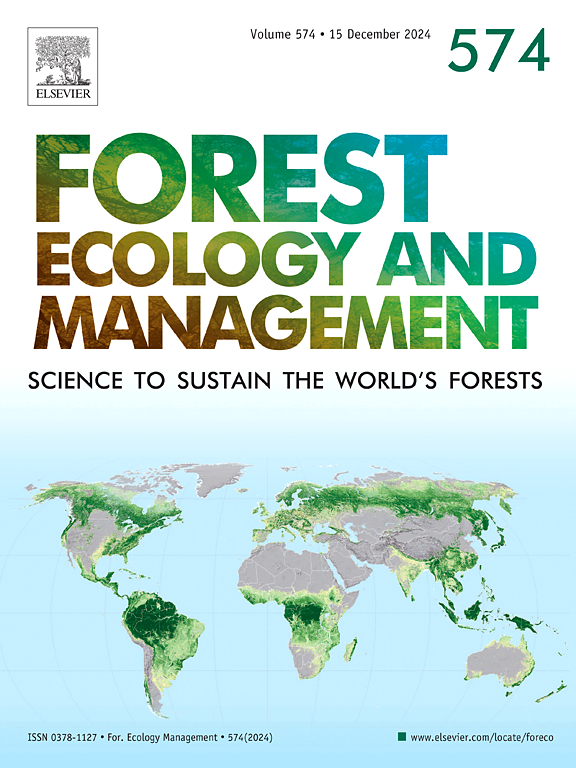次生林的碳回收:三个西非国家的启示
IF 3.7
2区 农林科学
Q1 FORESTRY
引用次数: 0
摘要
尽管热带次生林具有储存和固存大量碳的潜力,但人们对其地上碳储量及其影响因素却知之甚少,尤其是在西非。如果该地区的国家想要实现其森林恢复和气候减缓的承诺,这些信息就显得至关重要。为了填补这一空白,我们在几内亚、塞拉利昂和利比里亚的七个地点调查了环境和当地管理(如残留树木)因素如何影响次生林的 AGC 和树种丰富度。我们在休耕地建立了 140 个地块(20 x 50 米)(每个地点 20 个地块),并按照标准化方案对所有直径≥10 厘米的树木进行了采样。我们发现,AGC 储量和树种丰富度随休耕年龄的增长而增加,但受气候和当地管理措施的影响,不同地点的差异很大。干旱胁迫对 AGC 有负面影响,而残留树木则有正面影响。AGC 恢复率介于 0.72 兆克碳/公顷-年(第二干旱地区)和 13.76 兆克碳/公顷-年(最潮湿地区)之间。由于成本较低,我们的研究结果凸显了次生林被动恢复固碳的潜力,尤其是在较潮湿的地貌和有先前土地利用遗留树木的地区。本文章由计算机程序翻译,如有差异,请以英文原文为准。
Carbon recovery in secondary forests: Insights from three West African countries
Despite the potential of secondary tropical forests to store and sequester substantial amounts of carbon, little is known about their above-ground carbon (AGC) stocks and the factors affecting them, especially in West Africa. This information is of key importance if the countries in this region want to achieve their forest restoration and climate mitigation commitments. To fill in this gap, we investigated how environmental and local management (e.g. remnant trees) factors influenced AGC and tree species richness in secondary forests at seven sites across Guinea, Sierra Leone and Liberia. We established 140 plots (20 x 50 m) in fallows <15 years (20 plots per site) and sampled all trees ≥10 cm diameter following standardised protocols. We found that AGC stocks and tree species richness increased with fallow age, but were highly variable across sites driven by both climatic and local management practices. While drought stress negatively affected AGC, remnant trees had a positive effect. AGC recovery rates ranged between 0.72 Mg C ha−1 y−1 (second driest site) and 13.76 Mg C ha−1 y−1 (wettest site). Given its low cost, our findings highlight the potential of passive restoration in secondary forests for carbon sequestration, particularly in wetter landscapes and areas with remnant trees from prior land use.
求助全文
通过发布文献求助,成功后即可免费获取论文全文。
去求助
来源期刊

Forest Ecology and Management
农林科学-林学
CiteScore
7.50
自引率
10.80%
发文量
665
审稿时长
39 days
期刊介绍:
Forest Ecology and Management publishes scientific articles linking forest ecology with forest management, focusing on the application of biological, ecological and social knowledge to the management and conservation of plantations and natural forests. The scope of the journal includes all forest ecosystems of the world.
A peer-review process ensures the quality and international interest of the manuscripts accepted for publication. The journal encourages communication between scientists in disparate fields who share a common interest in ecology and forest management, bridging the gap between research workers and forest managers.
We encourage submission of papers that will have the strongest interest and value to the Journal''s international readership. Some key features of papers with strong interest include:
1. Clear connections between the ecology and management of forests;
2. Novel ideas or approaches to important challenges in forest ecology and management;
3. Studies that address a population of interest beyond the scale of single research sites, Three key points in the design of forest experiments, Forest Ecology and Management 255 (2008) 2022-2023);
4. Review Articles on timely, important topics. Authors are welcome to contact one of the editors to discuss the suitability of a potential review manuscript.
The Journal encourages proposals for special issues examining important areas of forest ecology and management. Potential guest editors should contact any of the Editors to begin discussions about topics, potential papers, and other details.
 求助内容:
求助内容: 应助结果提醒方式:
应助结果提醒方式:


